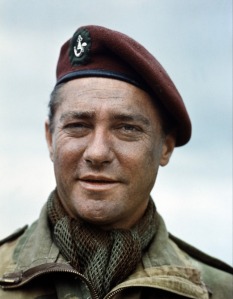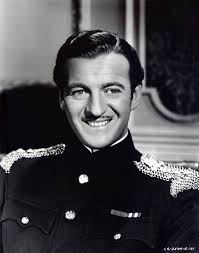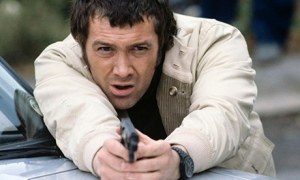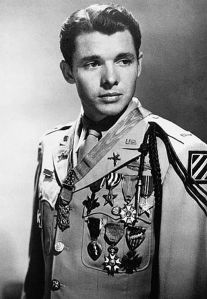I first heard the phrase ‘Do you talk the walk or walk the talk?’ as a child. It came from the lips of John Wayne and it has stuck with me ever since, particularly when someone uses it incorrectly and refers to ‘walking the walk and talking the talk’. At such moments my inner pedant bristles. That peculiar foible aside, it’s nice to know whether someone ‘walks the talk’ or merely ‘talks the walk’.
In the past few days that phrase came up during references to Mixed Martial Arts fighter Conor McGregor, from Dublin. Pundits wondered if he would ‘walk the talk’ when it came to his interim title fight in Las Vegas last week with top contender Chad Mendes. It turned out that McGregor could, indeed, back up his boasting. In Dublinese, he wasn’t ‘all mouth and no trousers’.
Doubts of a similar nature have been cast against the late great actor Christopher Lee, concerning his wartime record.
Amongst his 356 movies, Lee is best remembered for his role as Dracula in the Hammer Horror-produced films and as Bond villain Scaramanga in The Man With The Golden Gun. His career had a resurgence when he played the wizard Saruman in The Lord of the Rings series.
But it is with a previous role that I wish to mention him. During World War II Lee is said to have served with Special Operations Execute (SOE) and the Long Range Desert Group (which was a precursor to the SAS).
Due to Lee’s refusal to speak about his war service, the information concerning his actual role remains sketchy and, according to one historian of the SAS, it is somewhat inflated.
In an interview with The Spectator magazine, Gavin Mortimer, who specialises in SAS history, claims Lee had ‘led on’ the public to believe he played a bigger role.
‘Lee didn’t exactly lie, but he did lead us on, encouraging us to believe it had involved more… than it actually did,’ claims Mortimer.
So, did the actor ‘walk the talk?’ Well, Lee did serve as an RAF intelligence officer in Africa and also had some involvement with the SOE and SAS. At the end of the war he became a Nazi hunter, a job which required him visiting concentration camps.
Personally, I can’t see what Mortimer’s problem is, but here’s something else that might illustrate Lee’s mettle.
While filming on Lord of The Rings, a scene required Lee’s character to be stabbed in the back. Director Peter Jackson wanted Lee to cry out in pain when the ‘blade’ entered.
Lee refused, saying: ‘Peter, have you ever heard the sound a man makes when he’s stabbed in the back?’
The director admitted that he hadn’t.
‘Well, I have, and I know what to do.’
Enough said…
Lee isn’t the only actor who walked the talk, though. One of my favourites, David Niven (for a real laugh and a great insight into the golden days of Hollywood you have to read The Moon’s A Balloon’), did likewise.
Niven was a British actor, debonair, good-looking and charming. He invariably played the hero in movies – he starred in The Charge of the Light Brigade, Dawn Patrol and The Prisoner of Zenda, amongst other films – but he was also something of a hero himself during the war.
Niven trained as an elite Commando and took part in the invasion of Normandy in 1944. He commanded a specialist reconnaissance unit called Phantom, which located and reported enemy positions.
It’s nice to know that Niven not only looked the part of a brave officer in his films but did so in real life, too.
 Another star who did likewise was Richard Todd. He was actually Irish, but played stiff-upper-lip types in his roles. Todd was one of the very first men on the ground on D-Day. He was a captain in the parachute regiment and played a key role in the daring night-time operation to seize Pegasus Bridge.
Another star who did likewise was Richard Todd. He was actually Irish, but played stiff-upper-lip types in his roles. Todd was one of the very first men on the ground on D-Day. He was a captain in the parachute regiment and played a key role in the daring night-time operation to seize Pegasus Bridge.
The movie, The Longest Day portrayed that raid. Interestingly, Todd had a role in the movie – not playing himself (some other actor did that), but his commanding officer during the raid.
I can only imagine what was going through the movie director’s mind as he told Todd how to play the scene.
Growing up in the Seventies I used to champ at the bit waiting for the latest episode of The Professionals to hit the screen. The show involved two British SAS-type plainclothes men who did all manner of daring things for queen and country. One of the stars, Lewis Collins, was mean and moody and certainly looked the part. The fact that he used to be a hairdresser before he got the role is neither here nor there.
Collins would find himself typecast in action man roles for the rest of his career. He tried out for the role of James Bond but never made it . . . being deemed ‘too aggressive’ to play 007. Ironically, if he was around today, Collins would have made for a great Bond.
The other thing about Collins was that he was obviously tough as nails. Aside from achieving fame in The Professionals, he starred in the SAS movie, Who Dares Wins.
Privately, he yearned to join the elite regiment. He even passed the rigorous and debilitating selection course to become a member of the Territorial SAS (part-time members, but no-less effective) but was refused admission due to his celebrity. Collins had to content himself by training with 3 Company of the 10th (V) Battalion Parachute Regiment instead.
That great Hollywood star James Stewart was another whose real life actions could overshadow any heroic role he ever played in the movies.
Stewart, who played a string of cowboy roles as well as starring in the likes of It’s A Wonderful Life, Rear Window and Vertigo, was the first A-list Hollywood star to enlist, joining a bombing squadron when America went to war against Japan and Germany.
He also became the highest-ranked star (a Colonel) and the most decorated (the Air Medal, the Distinguished Flying Cross, the Croix de Guerre and seven battle stars).
Stewart continued to serve in the Air Force Reserve for a further 22 years, working on a military base during the Korean War, and even flying a non-combat mission in Vietnam. He was a one-star general in the USAF by the time he retired.
Finally, one can’t talk about heroic stars without mentioning Audie Murphy, who was one of the most decorated US combat soldier in World War II, having received every military combat medal the army could award, including the Medal of Honour.
Murphy won that for single-handedly holding off an entire company of German soldiers (over two hundred men) for an hour and managing to lead a counterattack while wounded.
His bravery and cherubic good looks found him fame in Hollywood after the war, when he starred in a slew of westerns, as well as his own biopic. To Hell And Back.
Quite simply put, when it comes to living up to the hype, Murphy could not only walk the talk, he could run, waltz and sashay it too.
To all those stars who earned their stripes, we salute you.







Indeed!!! Jimmy Stewart was some man!
LikeLike
That he was Adrienne. Thanks for stopping by.
LikeLike
Thank you for this bit of Hollywood and wartime history. Jimmy Stewart was one of my favorite actors.
LikeLike
One of mine, too, Mary. I’m glad you liked the post.
LikeLike
Very interesting, I had no history on English stars. I know that Lee Marvin was also somewhat of a hero and I am sure there were others. Robert Montgomery was a bomber pilot that went through training with my uncle.
LikeLike
Thanks Fred. I think I’ll be revisiting this one
LikeLike
The list goes on and on. This post reminds me of James Doohan (Scottie from Star Trek), who lost a part of finger while fighting for the Canadians on D-day.
LikeLike
I thought there might be a few more. I may have to revisit this topic in the future. Beam me up!
LikeLike
Thanks for shining the light on these men who were heros on the battlefield as well as on the silver screen.
LikeLike
Thanks Carol
LikeLike
Reblogged this on Rogues & Vagabonds.
LikeLike
Thanks for the reblog!
LikeLike
I cannot imagine that Christopher Lee exaggerated his military service. If anything, he was especially tight-lipped about it. One of the few detailed statements that Lee made regarding his experiences during World War II is the following…
“I’ve seen many men die right in front of me – so many in fact that I’ve become almost hardened to it. Having seen the worst that human beings can do to each other, the results of torture, mutilation and seeing someone blown to pieces by a bomb, you develop a kind of shell. But you had to. You had to. Otherwise we would never have won.” (Source: http://forces.tv/60797077)
It seems to me that Lee was someone who, whatever the specifics of his time in the armed forces, regarded his actions not as heroic or brave but as him doing his duty to protect his country. It is sometimes observed that most real heroes do not think of themselves as heroes, but merely as people who were attempting to do the right thing under difficult circumstances. That appears to be the case here.
LikeLike
I couldn’t agree with you more, Ben. Like so many of his generation, Lee did what he had to do when he was called upon to do so, and then kept his mouth shut about it.
LikeLiked by 1 person
Fantastic tribute to these brave men of the Greatest Generation. Thanks for sharing their stories.
LikeLike
I’m glad you liked it Nancy. Thanks.
LikeLike
Pingback: The Stars Who Earned Their Stripes | historywithatwist | First Night History
Reblogged this on Lenora's Culture Center and Foray into History.
LikeLike
Thanks for the reblog!
LikeLike
Australian actor Charles “Bud” Tingwell served with 260 Squadron (RAF) in North Africa and Sicily and then flew with 87 Squadron (RAAF) in the Dutch East Indies.
LikeLike
Another one for the list, thanks!
LikeLike